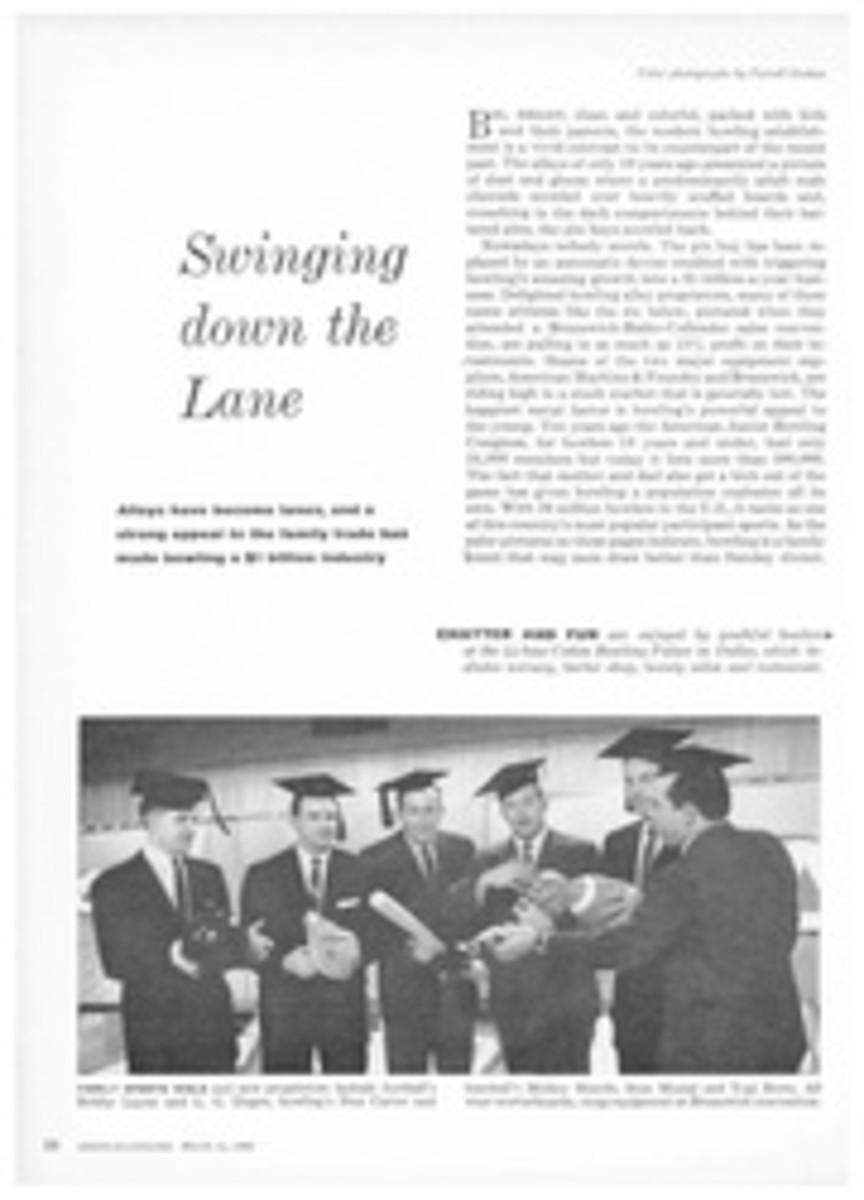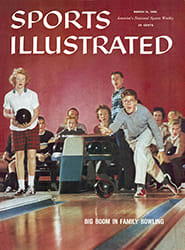
The master traders
The bright bulb of publicity has illuminated the many trades of Frank Lane and the warm, fraternal swaps between the Yankees and Kansas City. But few people are aware that for some years now the Giants (first in New York and then in San Francisco) have been making baseball's most successful deals. A trade won the Giants a pennant in 1951. A trade won them a pennant in 1954. A trade almost won them another last year. Now two trades, completed this winter, have made them favorites to win the pennant this year.
From the Baltimore Orioles they got Billy O'Dell, at times one of the best left-handers in baseball, and Billy Loes, an excitable but often competent right-hander. For these two pitchers the Giants parted with Jackie Brandt, a young and skillful but expendable outfielder, and two lesser players. From the St. Louis Cardinals the Giants acquired Don Blasingame, an exceptionally gifted second baseman who should be just what the porous Giant infield needs, giving in return their own second baseman, Daryl Spencer, a good hitter but a sometimes erratic fielder, and another expendable outfielder, Leon Wagner. Thus the Giants greatly strengthened their two weak spots of last season—pitching and defense—at the expense of one somewhat questionable infielder and two reserve outfielders.
Successful trades like these are complicated, time-consuming affairs, worked to profitable conclusions with great patience. Both were completed in December, but they had their beginnings long before. The Blasingame deal was discussed briefly at the end of the 1958 season. Talks were resumed during spring training of 1959, then dropped until World Series time. The two teams came closer by long-distance phone and finally reached agreement at the winter meetings in Florida.
The O'Dell-Loes deal, a particularly good example of the planning and patience that the Giants put into a trade, was born last August in an office in Seals Stadium, San Francisco. Present were Horace Stoneham, president of the club; his nephew Chub Fenney, vice-president; Tom Sheehan, chief scout; Frank Shellenback, special pitching coach; and Carl Hubbell, farm director. Sheehan, Shellenback and Hubbell were sent off to the American League to scout the White Sox and Indians for the World Series (the Giants were leading the National League at the time) and also to make a careful study of American League pitchers. With the interleague trading period coming up in the fall—three weeks when the National and American Leagues could trade freely with each other—Stone-ham and Feeney wanted to be well informed about pitchers, a pressing Giant need.
The three scouts reported back to San Francisco in mid-September. Another meeting was held, and the five men, plus Manager Bill Rigney, outlined some tentative trades. The White Sox, the Giants felt, might want an outfielder. So might the Yankees. The Giants knew Detroit would love to have either First Baseman Willie McCovey or Orlando Cepeda, who plays both first base and the outfield. Chances were good the Tigers would offer a top pitcher, say Frank Lary or Jim Bunning. But at this meeting in mid-September the Giants decided that they would trade neither Cepeda nor McCovey.
Of the eight teams in the American League, the one best suited for the Giants to deal with was Baltimore. The Orioles had a wealth of fine young pitchers—Milt Pappas, Jerry Walker, Billy O'Dell, Jack Fisher. They needed outfielders, and because the Giant farm system had produced an extraordinary number of good young outfielders San Francisco had outfielders to spare. The Giants began planning trades with Baltimore.
Two weeks later the Giants had collapsed, the Dodgers had won the pennant, and Stoneham and Feeney were in Chicago, watching the first game of the World Series. The fourth inning had just ended when Paul Richards, manager of the Orioles, stopped by the Giant box along the first-base line. The Giants, of course, were hardly surprised. Baltimore, too, was looking ahead to 1960. Richards asked Stoneham and Feeney if the two teams could get together for a little chat when the Series moved to Los Angeles. Swell, said the Giants.
In Los Angeles, Carl Hubbell, an old pitcher, talked with Paul Richards, an old catcher. Chub Feeney talked with Lee MacPhail, Baltimore's general manager. Feeney consulted Stoneham. The World Series ended without any definite agreement, but each team had a good idea what players the other wanted.
Meanwhile, the Giants had other offers for Brandt, who was obviously one of the available outfielders. The White Sox offered Billy Pierce or Dick Donovan, and for a long time the Giants considered it. The Pirates offered Ronnie Kline, and the Giants smiled.
At Thanksgiving, Stoneham and Feeney flew East for a dinner. Not just by chance, MacPhail went up to New York from Baltimore. It was at this time that the three men agreed upon the two key figures in the trade: O'Dell for Brandt. The matter of extra players was left open until everyone went to Florida for the winter meetings. There the final talks between the Giants and Orioles went smoothly, with one exception. Both sides had gathered at the Giants' suite in the Soreno Hotel, and newspapermen from both cities were waiting expectantly outside. Suddenly Paul Richards walked in and told MacPhail the Giants had a young catcher he liked, and he wanted him included in the trade. Negotiations hung in mid-air while this new facet of the deal was discussed privately by each side. Finally the trade was settled—O'Dell and Loes for Brandt, an obscure pitcher named Gordon Jones and a minor league catcher named Roger McCardell. "Done," said Chub Feeney. "Done," said Lee MacPhail.
This transaction illustrated a key reason why the Giants have been so successful with their trades. Brandt has wonderful promise, and the Giants hated to let him go. But in any trade if you want something good you have to give up something good. The Giants are keenly aware of this. They have been doing it for years.
After the 1949 season, the Giants knew they had to make a change. They had a team of heavy-footed sluggers who had set a major league home-run record in 1947 but who had finished fourth, fifth and fifth in successive seasons. At the December 1949 winter meetings the Giants, badly in need of a good second-base combination, talked to the Boston Braves, who were looking for power. After a dozen or so talks, the clubs made the biggest major league trade in years. The Giants got Alvin Dark and Eddie Stanky, the shortstop and second baseman who had helped the Braves to the 1948 pennant. In return the Giants gave the Braves Willard Marshall, Sid Gordon, Shortstop Buddy Kerr and a pitcher named Sam Webb. It looked like a lot to give up, perhaps too much. Marshall and Gordon had driven in 160 runs between them the year before. When the Braves opened the 1950 season in the Polo Grounds and crushed the Giants 11-4 and 10-6, The New York Times called the trade "an impulsive mistake." But the Giants straightened out. They came on with a rush to finish third in 1950, and they won the pennant the following year. Bobby Thomson's home run was the dramatic blow in 1951, but Dark and Stanky were the key men both years.
The Giants slipped to second in 1952 and all the way to fifth in 1953. Their two big pitchers of 1951, Sal Maglie and Larry Jansen, began to show their age. Again the Giant front office went to the Braves, by then of Milwaukee. They took a young bonus left-hander, Johnny Antonelli, and parted with their legendary Bobby Thomson, who had driven in over 100 runs three years in a row. It was a high price to pay for an unproved pitcher, but Antonelli won 21 games in 1954 and the Giants won another pennant.
Last spring the Giants were again woefully short of pitchers, so late in March they gave St. Louis two good hitters, Bill White and Ray Jablonski, for Sam Jones. Sam was pushing 34 and had never won more than 14 games in the majors. The Giants hated to trade White (who hit .302 for St. Louis). Again it was a gamble, but Jones won 21 games for the Giants, starting and relieving, and it was hardly his fault that the team, with the pennant seemingly in hand, lost seven of its last eight games to finish third.
There are some trades the Giants would just as soon forget, most notably the one in which they sent Red Schoendienst to Milwaukee for Ray Crone, Danny O'Connell and old alumnus Bobby Thomson. Schoendienst helped win two pennants for the Braves, but the others did almost nothing for the Giants. The Giants can console themselves with the knowledge that when they obtained Schoendienst from the Cardinals a year earlier in exchange for Alvin Dark, they also got a young fellow named Jackie Brandt, who, of course, has provided them with two new pitchers for 1960.
So now the Giants face the new season with a pitching staff—a good pitching staff—made up in large part of players from other teams. Antonelli is from Milwaukee, Jones from St. Louis, O'Dell and Loes from Baltimore, Stu Miller and Jack Sanford from Philadelphia. With hitters like Mays, Cepeda, McCovey and Kirk-land to provide runs, and fielders like Davenport, Bressoud and Blasingame to prevent them, it looks like a fine year, probably a pennant year, for San Francisco's cosmopolitan ball club. Should the Giants fail to win, you can bet they will go right on trading until they do.
PHOTO
HORACE STONEHAM HAS THE FINAL SAY
PHOTO
BALTIMORE'S O'DELL IS A GIANT NOW
PHOTO
BOBBY THOMSON won a pennant, but trading him brought the Giants another.
PHOTO
JOHNNY ANTONELLI, whom the Giants got for Thomson, became their star pitcher.
PHOTO
DON BLASINGAME, from St. Louis, is superior second baseman the Giants needed.

